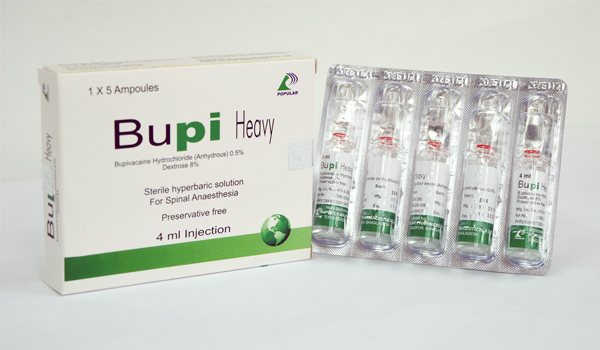Indication
Bupivacaine Heavy is indicated for the production of spinal anaesthesia for
- Urological surgery
- Lower limb surgery
- Abdominal surgery
Dosage & Administration
The doses recommended below should be regarded as a guide for use in the average adult Spinal anaesthesia for surgery: 2-4 ml (10-20 mg Bupivacaine hydrochloride). The spread of anaesthesia obtained with Bupivacaine depends on several factors including the volume of the solutions and the position if the patients during and following the injection. When injected in the L3-L4 intervertebral space with the patient in the sitting position, 3 ml of Bupivacaine spreads to the T7- T10 spinal segments. With the patient receiving the injection in the horizontal position and then turned supine, the blockade spine spreads to T4-T7 spinal segments. It should be understood that the level of spinal anaesthetic can be unpredictable in a given patient.
Precautions
The safety and effectiveness of spinal anaesthetics depend on proper dosage, correct technique, adequate precautions and readiness for emergencies. Resuscitative equipment, oxygen and other resuscitative drugs should be available for immediate use. The patient should have I.V. fluids running viaan indwelling catheter to assure a functioning intravenous pathway. The lowest dosage of local anaesthetic that results in effective anaesthesia should be used. Aspiration for blood should be performed before injection and injection should be made slowly. Tolerance varies with the status of the patient. Debilitated, elderly patients and acutely ill patients may require reduced doses. Reduced doses may also be indicated in patients with increased intra-abdominal pressure (including obstetrical patients), if otherwise suitable for spinal anaesthesia. There should be careful and constant monitoring of cardiovascular and respiratory (adequacy of ventilation) vital signs and the patient\'s state of consciousness after local anaesthetic injection. Restlessness, anxiety, incoherent speech, lightheadedness, numbness and tingling of the mouth and lips, metallic taste, tinnitus, dizziness, blurred vision, tremors, depression or drowsiness may be early warning signs of central nervous system toxicity. Spinal anaesthetics should be used with caution in patients with severe disturbances of cardiac rhythm, shock, or heart block. Sympathetic blockade occurring during spinal anaesthesia may result in peripheral vasodilation and hypotension, the extent depending on the number of dermatomes blocked. Blood pressure should, therefore, be carefully monitored especially in the early phases of anaesthesia. Hypotension may be controlled by vasoconstrictors in dosages depending on the severity of hypotension and response of treatment. The level of anaesthesia should be carefully monitored because it is not always controllable in spinal techniques.Use in Pregnancy:There are no adequate and well-controlled studies in pregnant women of the effect of Bupivacaine on the developing fetus. Bupivacaine Hydrochloride should be used during pregnancy only if the potential benefit justifies the potential risk to the fetus. This does not exclude the use of Bupivacaine Heavy at term for obstetrical anaesthesia.Use in Lactation :It is not known whether local anaesthetic drugs are excreted in human milk. Because many drugs are excreted in human milk, caution should be exercised when local anaesthetic drugs are administered to a nursing woman. Use in Children:Until further experience is gained in patients younger than 18 years, administration of Bupivacaine Heavy in this age group is not recommended.



